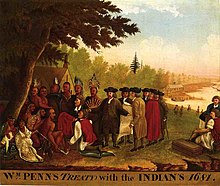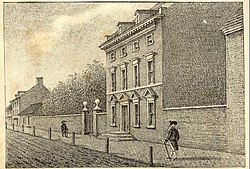Before the Commonwealth was settled by Europeans, the area was home to the Delaware (also known as Lenni Lenape), Susquehannock, Iroquois, Eriez, Shawnee, and other American Indian Nations. Both the Dutch and the English claimed both sides of the Delaware River as part of their colonial lands in America. The Dutch were the first to take possession, and this has impact on the history of Pennsylvania. By June 3, 1631, the Dutch had started up the DelMarVa Peninsula by establishing the Zwaanendael Colony on the site of present day Lewes, Delaware. In 1638, Sweden heated up the issue by establishing the New Sweden Colony, centered on Fort Christina, on the site of present day Wilmington, Delaware. New Sweden claimed and, for the most part, controlled the lower Delaware River region (Parts of present Delaware, New Jersey and Pennsylvania), but settled few colonists there.
On March 12, 1664, King Charles II of England gave James, Duke of York a Grant that included all of the lands included in the original Virginia Company of Plymouth Grant as well as other lands. This grant was – again – in conflict with the Dutch claim for New Netherland, which included parts of today’s Pennsylvania.
On June 24, 1664, The Duke of York sold the portion of his large grant that included present day New Jersey to John Berkeley and George Carteret for a proprietary colony. As of yet, the land was not in English possession, but the sale boxed in the portion of New Netherland on the West side of the Delaware River. The English conquest of New Netherland was commenced on August 29, 1664, when New Amsterdam was coerced to surrender facing the cannons on English ships in New York Harbor. This conquest continued, and was completed in October of 1664, when the English captured Fort Casimir in what today is New Castle, Delaware.
The Peace of Breda between England, France and the Netherlands confirmed the English conquest on July 21, 1667,although there were temporary reversions.
On September 12, 1672, as part of the Third Anglo—Dutch War, the Dutch re-conquered New York Colony/New Amsterdam, the Dutch established three County Courts which went on to become original Counties in present day Delaware and Pennsylvania. The one that later transferred to Pennsylvania was Upland. This was partially reversed on February 9, 1674, when the Treaty of Westminster ended the Third Anglo-Dutch War, and reverted all political situations to the Status Quo Ante Bellum. The English retained the Dutch Counties with their Dutch names. By June 11, 1674, New York reasserted control over the outlying colonies, including Upland, but the names started to be changed to English names by November 11, 1674. Upland was partitioned on November 12, 1674, producing the general outline of the current border between Pennsylvania and Delaware.
On February 28, 1681, Charles II granted a land charter to William Penn to repay a debt of £16,000 (around £2,100,000 in 2008, adjusting for retail inflation) owed to William's father, Admiral Penn. This was one of the largest land grants to an individual in history. It was called Pennsylvania, meaning "Penn's Woods", in honor of Admiral Penn. William Penn, who had wanted his province to be named "Sylvania", was embarrassed at the change, fearing that people would think he had named it after himself, but King Charles would not rename the grant. Penn established a government with two innovations that were much copied in the New World: the county commission and freedom of religious conviction.
What had been Upland on what became the Pennsylvania side of the Pennsylvania-Delaware Border was renamed as Chester County when Pennsylvania instituted their colonial governments on March 4, 1681. The Quaker leader William Penn had signed a peace treaty with Tammany, leader of the Delaware tribe, beginning a long period of friendly relations between the Quakers and the Indians. Additional treaties between Quakers and other tribes followed. The treaty of William Penn was never violated.
Between 1730 and when it was shut down by Parliament with the Currency Act of 1764, the Pennsylvania Colony made its own paper money to account for the shortage of actual gold and silver. The paper money was called Colonial Scrip. The Colony issued "bills of credit", which were as good as gold or silver coins because of their legal tender status. Since they were issued by the government and not a banking institution, it was an interest-free proposition, largely defraying the expense of the government and therefore taxation of the people. It also promoted general employment and prosperity, since the Government used discretion and did not issue too much to inflate the currency. Benjamin Franklin had a hand in creating this currency, of which he said its utility was never to be disputed, and it also met with the "cautious approval" of Adam Smith.
After the Stamp Act Congress of 1765, Delegate John Dickinson of Philadelphia, Pennsylvania, wrote the Declaration of Rights and Grievances. The Congress was the first meeting of the thirteen colonies, called at the request of the Massachusetts Assembly, but only nine colonies sent delegates. Dickinson then wroteLetters from a Farmer in Pennsylvania, To the Inhabitants of the British Colonies, which were published in the Pennsylvania Chronicle between December 2, 1767, and February 15, 1768.
When the Founding Fathers of the United States convened in Philadelphia in 1774, 12 colonies sent representatives to the First Continental Congress. TheSecond Continental Congress, which also met in Philadelphia (in May, 1775), drew up and signed the Declaration of Independence in Philadelphia, but when that city was captured by the British, the Continental Congress escaped westward, meeting at the Lancaster courthouse on Saturday, September 27, 1777, and then toYork. There they drew up the Articles of Confederation that formed 13 independent colonies into a new nation. Later, the Constitution was written, and Philadelphia was once again chosen to be cradle to the new American Nation.
Pennsylvania became the second state to ratify the U.S. Constitution on December 12, 1787, five days after Delaware became the first.
Dickinson College of Carlisle was the first college founded in the United States. Established in 1773, the college was ratified five days after the Treaty of Paris on September 9, 1783. The school was founded by Benjamin Rush and named after John Dickinson.
For half a century, the Commonwealth's General Assembly (legislature) met at various places in the general Philadelphia area before starting to meet regularly in Independence Hall in Philadelphia for 63 years. But it needed a more central location, as for example the Paxton Boys massacres of 1763 had made the legislature aware. So, in 1799 the General Assembly moved to the Lancaster Courthouse, and finally in 1812 to Harrisburg. The General Assembly met in the old Dauphin County Court House until December 1821,when the Federal-style "Hills Capitol" (named for its builder, Stephen Hills, a Lancaster architect) was constructed on a hilltop land grant of four acres set aside for a seat of state government by the prescient, entrepreneurial son and namesake of John Harris, Sr., a Yorkshire native who had founded a trading post in 1705 and ferry (1733) on the east shore of the Susquehanna River. The Hills Capitol burned down on February 2, 1897, during a heavy snowstorm, presumably because of a faulty flue. The General Assembly met at Grace Methodist Church on State Street (still standing) until the a new capitol could be built. Following an architectural selection contest that many alleged had been "rigged," Chicago architect Henry Ives Cobb was charged with designing and building a replacement building; however, the legislature had little money to allocate to the project, and a roughly finished, somewhat industrial building (the Cobb Capitol) was completed. The General Assembly refused to occupy the building. Political and popular indignation in 1901 prompted a second contest that was restricted to Pennsylvania architects, and Joseph Miller Huston of Philadelphia was chosen to design the present Pennsylvania State Capitol that incorporated Cobb's building into magnificent public work finished and dedicated in 1907.
The new state Capitol drew rave reviews. Its dome was inspired by the domes of St. Peter's Basilica in Rome and the United States Capitol. President Theodore Roosevelt called it "the most beautiful state Capitol in the nation" and said, "It's the handsomest building I ever saw" at the dedication. In 1989, the New York Times praised it as "grand, even awesome at moments, but it is also a working building, accessible to citizens ... a building that connects with the reality of daily life".
Pennsylvania accounts for nine percent of all wooded areas in the United States. In 1923 President Calvin Coolidge established the Allegheny National Forest under the authority of the Weeks Act of 1911 in the northwest part of the state in Elk, Forest, McKean, and Warren Counties for the purposes of timber production and watershed protection in the Allegheny River basin. The Allegheny is the state's only national forest.
James Buchanan, of Franklin County, was the only bachelor President of the United States and the only one to be born in Pennsylvania. The Battle of Gettysburg—-the major turning point of the Civil War—took place near Gettysburg. An estimated 350,000 Pennsylvanians served in the Union Army forces along with 8,600 African American military volunteers.
Pennsylvania was also the home of the first commercially drilled oil well. In 1859, near Titusville, Pennsylvania, Edwin L. Drake successfully drilled the well, which led to the first major oil boom in United States history.




No comments:
Post a Comment